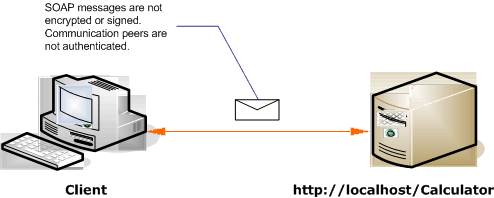Internet: Ungesicherter Client und Dienst
Die folgende Illustration zeigt ein Beispiel eines öffentlichen, ungesicherten Windows Communication Foundation (WCF)-Clients und eines Diensts an:

| Merkmal | Beschreibung |
|---|---|
| Sicherheitsmodus | Keine |
| Transport | HTTP |
| Bindung | BasicHttpBinding im Code oder das Element <basicHttpBinding> in der Konfiguration. |
| Interoperabilität | Mit vorhandenen Webdienstclients und Diensten |
| Authentifizierung | Keine |
| Integrität | Keine |
| Vertraulichkeit | Keine |
Dienst
Der folgende Code und die folgende Konfiguration werden unabhängig voneinander ausgeführt. Führen Sie eines der folgenden Verfahren aus:
Erstellen Sie einen separaten Dienst, indem Sie den Code ohne Konfiguration verwenden.
Erstellen Sie mit der angegebenen Konfiguration einen Dienst, aber definieren Sie keine Endpunkte.
Code
Im folgenden Code wird gezeigt, wie ein Endpunkt ohne Sicherheit erstellt wird: Standardmäßig verfügt die BasicHttpBinding über den Sicherheitsmodus None.
Uri httpUri = new Uri("http://localhost/Calculator");
// Create the ServiceHost.
ServiceHost myServiceHost = new ServiceHost(typeof(Calculator), httpUri);
// Create a binding that uses HTTP. By default,
// this binding has no security.
BasicHttpBinding b = new BasicHttpBinding();
// Add an endpoint to the service.
myServiceHost.AddServiceEndpoint(typeof(ICalculator), b, "");
// Open the service and wait for calls.
AddMexEndpoint(ref myServiceHost);
myServiceHost.Open();
Console.Write("Listening....");
Console.ReadLine();
// Close the service when a key is pressed.
myServiceHost.Close();
Dim httpUri As New Uri("http://localhost/Calculator")
' Create the ServiceHost.
Dim myServiceHost As New ServiceHost(GetType(Calculator), httpUri)
' Create a binding that uses HTTP. By default,
' this binding has no security.
Dim b As New BasicHttpBinding()
' Add an endpoint to the service.
myServiceHost.AddServiceEndpoint(GetType(ICalculator), b, "")
' Open the service and wait for calls.
AddMexEndpoint(myServiceHost)
myServiceHost.Open()
Console.Write("Listening....")
Console.ReadLine()
' Close the service when a key is pressed.
myServiceHost.Close()
Dienstkonfiguration
Mit dem folgenden Code wird derselbe Endpunkt mithilfe von Konfiguration eingerichtet.
<?xml version="1.0" encoding="utf-8"?>
<configuration>
<system.serviceModel>
<behaviors />
<services>
<service behaviorConfiguration="" name="ServiceModel.Calculator">
<endpoint address="http://localhost/Calculator"
binding="basicHttpBinding"
bindingConfiguration="Basic_Unsecured"
name="BasicHttp_ICalculator"
contract="ServiceModel.ICalculator" />
</service>
</services>
<bindings>
<basicHttpBinding>
<binding name="Basic_Unsecured" />
</basicHttpBinding>
</bindings>
<client />
</system.serviceModel>
</configuration>
Client
Der folgende Code und die folgende Konfiguration werden unabhängig voneinander ausgeführt. Führen Sie eines der folgenden Verfahren aus:
Erstellen Sie mit dem Code (und Clientcode) einen eigenständigen Client.
Erstellen Sie einen Client, der keine Endpunktadressen definiert. Verwenden Sie stattdessen den Clientkonstruktor, der den Konfigurationsnamen als Argument verwendet. Zum Beispiel:
CalculatorClient cc = new CalculatorClient("EndpointConfigurationName");Dim cc As New CalculatorClient("EndpointConfigurationName")
Code
Im folgenden Code wird ein grundlegender WCF-Client gezeigt, der auf einen ungesicherten Endpunkt zugreift.
// Create an instance of the BasicHttpBinding.
// By default, there is no security.
BasicHttpBinding myBinding = new BasicHttpBinding();
// Create the address string, or get it from configuration.
string httpUri = "http://localhost/Calculator";
// Create an endpoint address with the address.
EndpointAddress myEndpoint = new EndpointAddress(httpUri);
// Create an instance of the WCF client. The client
// code was generated using the Svcutil.exe tool.
CalculatorClient cc = new CalculatorClient(myBinding, myEndpoint);
try
{
cc.Open();
// Begin using the calculator.
Console.WriteLine(cc.Divide(100, 2));
// Close the client.
cc.Close();
}
catch (TimeoutException tex)
{
Console.WriteLine(tex.Message);
cc.Abort();
}
catch (CommunicationException cex)
{
Console.WriteLine(cex.Message);
cc.Abort();
}
finally
{
Console.WriteLine("Closed the client");
Console.ReadLine();
}
' Create an instance of the BasicHttpBinding.
' By default, there is no security.
Dim myBinding As New BasicHttpBinding()
' Create the address string, or get it from configuration.
Dim httpUri As String = "http://localhost/Calculator"
' Create an endpoint address with the address.
Dim myEndpoint As New EndpointAddress(httpUri)
' Create an instance of the WCF client. The client
' code was generated using the Svcutil.exe tool.
Dim cc As New CalculatorClient(myBinding, myEndpoint)
Try
cc.Open()
' Begin using the calculator.
Console.WriteLine(cc.Divide(100, 2))
' Close the client.
cc.Close()
Catch tex As TimeoutException
Console.WriteLine(tex.Message)
cc.Abort()
Catch cex As CommunicationException
Console.WriteLine(cex.Message)
cc.Abort()
Finally
Console.WriteLine("Closed the client")
Console.ReadLine()
End Try
Clientkonfiguration
Der folgende Code dient zum Konfigurieren des Clients.
<?xml version="1.0" encoding="utf-8"?>
<configuration>
<system.serviceModel>
<bindings>
<basicHttpBinding>
<binding name="BasicHttpBinding_ICalculator" >
<security mode="None">
</security>
</binding>
</basicHttpBinding>
</bindings>
<client>
<endpoint address="http://localhost/Calculator/Unsecured"
binding="basicHttpBinding"
bindingConfiguration="BasicHttpBinding_ICalculator"
contract="ICalculator"
name="BasicHttpBinding_ICalculator" />
</client>
</system.serviceModel>
</configuration>